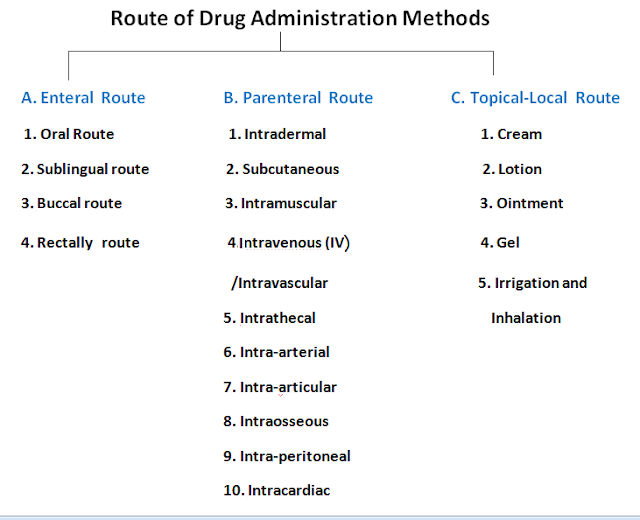What are Drugs?
The drug is a substance used in diagnosing,
preventing or treatment of disease.
The drug is any substance or product that
is used or intended (plan) to be used to modify or explore the physiological
system and pathological status for the benefit of the recipient.
Example: To prevent any alteration of body system due to
Allergy
To know what a Drug
Does to the Body; pharmacodynamics
of drugs.
Different Route of Drug Administration
A route of drug/ medication administration is the
path by which a drug or a substance is brought into contact with the body.
To administer Drugs, Check out here what are the rights of the Drug Administration?
Route of drug administration is given to patients depending on the properties of the drug and requirements of patients.

![]()
1. Enteral Route
For enteral route method having the
involvement of esophagus, stomach, and small intestine; gastrointestinal tract.
1. Oral route
In this method, the drug is swallowed
orally and absorbed by the stomach and small intestine.
Example: capsule, tablet, or chewable tablet
2. Sublingual route
Drug placed under the tongue.
Example: Nitroglycerine
3. Buccal route
Drug placed between gum and cheek.
Dissolved and
directly absorbed into a small blood vessel.
4. Rectally or Vaginal route
For example,
Acetaminophen: for fever
Laxatives:
for constipation
Enema; Administers of drug liquid form into
the rectum.
Advantages of Enteral Route
The advantages of the enteral route of drug administration are -
1. Safest route
2. Convenient route
3. Self administer
4. Painless and acceptable
5. Cost-effective
6. Non Invasive route
7. Most Economical
8. No strict sterilization
Disadvantages of Enteral Route
The disadvantages of the enteral route of drug administration are -
1. Interaction of drug with food
affects the absorption
2. Drug absorption may be slower, needs
time to absorb
3. Make cause nausea and vomiting due
to irritation in G.I Tract
4. Administration is difficult for an
unconscious and un-cooperative patient
5. Some drugs are destroyed by the
gastric mucosa
6. Some drugs undergo extensive
first-pass metabolism in the liver
Contraindication of Enteral
Route of Drug Administration
These are the contraindication of the enteral route of drug administration-
1. Continuous vomiting and nausea
2. Unconsciousness patient
3. Patients who are unable to swallow
(dysphagia)
4. Patient in an NPO- Nil Per Oral
5. Gastric or intestinal suction
2. Parenteral Route
Administered by Injection using needle
and syringe.
Parts of needle and
syringe; barrel and plunger,
shaft.
Check out the angle of Intramuscular, Intradermal, Subcutaneous, Intravenous injection given by different angles of injection administration.
Parenteral
route of administration methods -
1. Intradermal route
Injection
administered into the dermis.
Example: BCG Vaccine
2. Subcutaneous route
Beneath
the skin.
Example: insulin, heparin
3. Intramuscular route
Injection administered into a muscle, large skeletal muscle; deltoid, triceps, gluteus, Rectus femoris.
4. Intravenous/intravascular (I.V)
Administration
of medication into a vein, given with the help of an infusion set.
5. Intrathecal route
Deliver
drug around spinal the cord.
6. Intra-arterial route
Administration of
a drug injected into an artery.
7. Intraosseous route
Injecting
the drug into the bone marrow.
8. Intra-articular route
Administration of injection
into the joint cavity.
9. Intracardiac route
The injection is given into the heart muscle or ventricle.
10. Intraperitoneal route
Injection
of medication into the peritoneum (body cavity:
an area that contains abdominal organ).
Advantages of Parenteral Route
The advantages of the
parenteral route are-
1. Action is more rapid and quickly
absorbed
2. Administer for Unconscious and
uncooperative patient
3. Used inpatient with vomiting and
nausea
4. Administration in a patent who is
unable to swallow
5. Avoid first-pass metabolism
6. Useful in emergency
Disadvantages of Parenteral Route
The disadvantages of the parenteral route are-
1. Asepsis must be maintained
2. Maybe painful
3. More Expensive
4. Maybe Injury to nerve and tissue
3. Topical Route
Topical application is those apply to a
particular place, skin surface, or apply body surface area and get absorbed,
mainly for local action.
Check out here common drug prescription abbreviations.
1. Cream, Lotion
2. Ointment
4. Gel
5. Irrigation, inhalation, and nebulization;
breathing into lungs
a. Nasal route
Budesonide nasal spray; spray into the
nose and absorbed through the nasal membrane.
b. Ocular route
for example, Eye drop
c. Otic route
for example, Eardrop







0 Comments